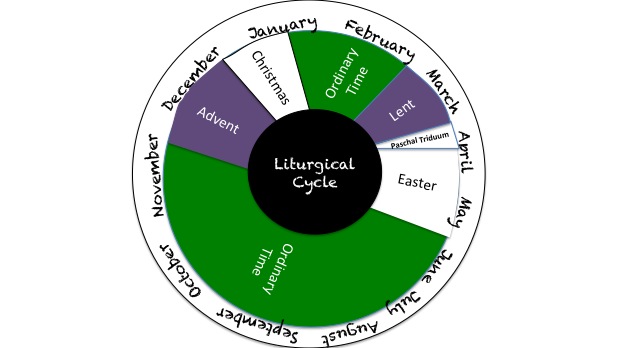Celebrate the Liturgical Seasons

Parenting Basics –> What Works? –> Participate in the Life & Mission of the Church –> Celebrate the Liturgical Seasons
The Bible tells us that there is an appointed time for everything (Eccl 3:1). The Catholic Church marks the special feasts and seasons of each calendar year in the liturgical calendar.
Knowing the basics of and celebrating the liturgical year within your home is a wonderful way to share in the life and mission of the Church. The calendar guides you to new and exciting ways to celebrate the Saints of the Church on their given feast days and to more fully understand all of the seasons of our faith.
In particular, learning more about the liturgical calendar helps you identify when seasons of the Church begin and end. For example, the season of Advent is the time before Christmas. This season has its own beautiful celebration that is distinct from Christmas. Celebrating Advent builds a sense of anticipation for Christmas and helps us to prepare our hearts for a more meaningful celebration of the birth of Jesus. And the Christmas season is the time from the birth of our Lord on December 25th until the feast of the Baptism of our Lord which is nearly three weeks after Christmas Day. This season includes the great family feast days of the Holy Family, the Solemnity of Mary, the Epiphany of the Lord and the Lord’s Baptism. Knowing the liturgical calendar gives your family permission to stay in the Christmas spirit through the early days of January rather than end them on December 26th.
In addition to the seasons of the Church, the calendar reveals the type of season or feast being celebrated by the color of the vestments worn at Mass. White means the liturgy expresses light, purity, and glory. Red expresses martyrdom (dying for the faith), Jesus’ passion and the fire of God’s love. Green represents life in the Holy Spirit during the ordinary times of the Church. Violet shows a time of penance, sacrifice, and preparation. Rose is the color of joy and hope.
Once you have a handle on the calendar, you will be able to find ways to “celebrate” the liturgy of each day at home. On feast days you can serve dessert. On fast days you can serve a more modest menu. You may choose to read stories of the Saints to your children instead of just any old book. You can wear clothing that matches the colors of the various liturgies. The connections between the calendar and daily life are endless!
Most importantly, knowing and celebrating according to the liturgical calendar connects your “domestic church” (your home) and your family to the Universal Church and the family of God. It brings the faith home.
